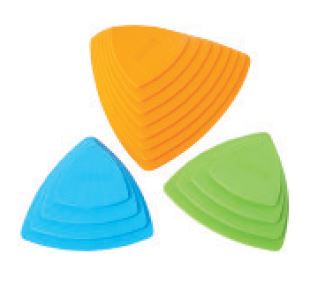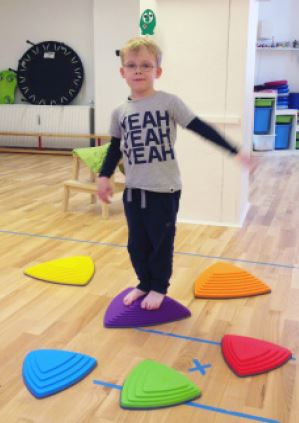Stabiliteitstraining met rivierstenen stappenset
Het thema van dit artikel is statische balans, en hoe de rivierstenen stappenset gebruikt kan worden bij kinderen met stabiliteitsproblemen.
Er zijn 3 typen balans: dynamische balans, proactieve balans en statische balans.
Dynamische balans:
Dynamische balans gebruiken we als we bewegen en tegelijk onze balans houden. We houden onze balans op een steunoppervlak, en hoe groter het steunoppervlak hoe makkelijker het is om onze balans te houden. Versnelling en bewegingssnelheid helpen ook bij het houden van de balans. We kennen allemaal bijvoorbeeld de situatie dat we op een fiets bijna stilstaan en dan bijna omvallen, maar door net even te versnellen voorkom je dat je omvalt. Wanneer we versnellen, helpt het vestibulair systeem om de balans te behouden. Als we bijna onze balans verliezen, reageren we vaak in een reflex om te voorkomen dat we vallen, door bijvoorbeeld met onze armen te zwaaien. Fietsen vereist bijvoorbeeld een goede dynamische balans.
Proactieve balans:
Proactieve balans is vermogen om te voorspellen wat je nodig hebt om je balans te houden voordat je het doet, bijvoorbeeld we weten precies hoeveel spanning en elasticiteit we in onze benen nodig hebben wanneer we willen springen of wanneer we ons evenwicht willen bewaren als we op een onstabiele ondergrond gaan landen. Als we de beweging verkeerd inschatten, dan landen we zwaar of onhandig of verliezen onze balans.
Statische balans:
Statische balans is het vermogen om een bepaalde positie te handhaven, bijvoorbeeld wanneer we op een been staan of wanneer we ons lichaam in een bepaalde houding kunnen houden voor een langere periode, zoals wanneer je werkt achter een bureau.
Wanneer alle drie de systemen gecoördineerd werken, bewegen we vloeiend en elegant, en werkt ons lichaam optimaal en efficiënt, zonder onnodige spanning.
Bij spelen en bewegen, zijn alle drie de typen balans gecoördineerd. Elke type balans heeft een sterke invloed op de andere twee typen.
Kinderen hebben soms problemen met een of meerdere typen balans. Voor effectieve training is het belangrijk dat de therapeut analyseert welk type balans zwak is en oefent met het type balans wat het kind moeilijk vindt.
Hieronder vindt u een case van Therapeut Hanna Harboe, waarin zij een voorbeeld schetst hoe de statische balans getraind kan worden met de Rivierstenen Stappenset.
CASE
Mark, a very active boy, aged 5 years. He has always moved around a lot. He can ride a bicycle well and is good at running and boisterous play. But he literally can’t stand still. He falls to the ground. He falls from his chair at mealtimes. He is unable to stand on one leg. When seated at the table, he rests his head on the table. When playing with cars on the floor, he lies down and rests his head on his upper arm instead of sitting.
When asked to complete a motor skills trail at my clinic, he is through it before I have finished instructing him in what he has to do: Quick as a flash, he is through it, jumping and running at a great rate of knots. He finds dynamic balance easy, he has good proactive balance, but static balance is difficult. I praise Mark. He’s a good boy, but I explain we have to try something more diffi¬cult as I get the impression that he finds it difficult to move slowly. Mark nods. The adults have always chided him: take it easy, slow down and relax. Maybe Mark doesn’t know how? Because when he does relax, he falls and loses his balance.
Now we have a common goal: I will help Mark to master what he finds difficult, i.e. slowing the pace. I will teach him how to move slowly. In professional terms, he has to learn static balance and physical stability.
I bring out the River Stones and ask Mark to stand on a high stone in the middle. Small River Stones in different colours are scattered around the high stone. I ask
Mark to put one foot on a stone of a specific colour. The other foot must remain on his “base”, the high River Stone.
Each time I say a new colour, Mark starts with both feet on the high River Stone and then he chooses which foot to use to rest on a smaller stone of the correct colour. This exercise slows Mark down. He has to make a special effort to keep his balance, when both feet are on the high River Stone and then allow for the difference in height, when he has his feet on stones of different heights. This exercise helps train static balance. After he has had one foot on a coloured stone, Mark must remember to return both feet to the middle stone. This encourages him to reduce speed even further and is yet more challenging. Mark chuckles every time he forgets to return to base and moves directly from one low River Stone to another. We laugh at his mistakes and I praise him when he concentrates and remembers to return to base before choosing a new River Stone.
I can make the exercise more difficult. I can delay the process and take my time when choosing a new colour. The slower I am, the more challenging the exercise for Mark’s static balancing skills. I can also change the degree of difficulty by alternately choosing a stone that is close to the high base stone and one that is behind it or by switching from left to right. I can also make it more difficult still. I tell Mark that he cannot decide for him¬self which foot to use, but that he must use his right and left foot alternately.
If Mark was not able to keep his balance during the exercise or was unable to wait for me to dictate the colour, a more simple game would be to lay all the River Stones in a random pattern and ask Mark to stand with both feet on the stone I ask him to.
It is important that I match the child’s level, give him or her challenges and a simultaneous sense of success and mastery. After only a few minutes, Mark no longer makes mistakes. He masters the game. He succeeds in slowing the pace and keeping his balance.
We agree that I give him five more colours and then the game will end.
Copyright: © Gonge Creative Learning Aps 2015

